The oldest restaurants and cafes in Lisbon
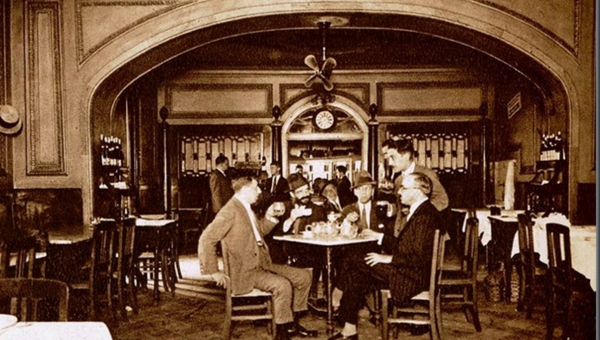
Some of the most iconic and long lasting businesses in Lisbon are food and drink related. There is no doubt that the people of our city love to go out to eat, drink and hang out with friends, and it seems that it has been that way for at least a couple of centuries now.
Lisbon’s coffee shop scene and overall coffee culture is intrinsically related with the arts scene, for example. In the old times, intellectuals would gather in cafes to discuss the latest cultural and political ideas, and this is the time when drinking coffee started being popularized, at the beginning of the 19th century.

Photo by Pastelaria Benard
In parallel, Lisbon’s restaurants evolved from simple taverns which would at first only serve drinks. Eventually, over time, tavern owners felt that it was a good business opportunity to start serving food, especially as customers were mainly peasants who’d come to the city from the countryside relatively nearby, and who’d have to eat something before making the trip back home. If at first these tascas had a fixed one pot dish they’d serve on a given day, eventually their offerings were extended, until the establishments evolved into the concept of full-on restaurants with a menu we know of today. It’s fascinating to think that the places and the way they conduct business would have changed over time but that, some of them, not only are still open, but have been running non-stop ever since!
Today, we pay tribute to some of the oldest cafes and restaurants in Lisbon. Not only do they serve food that is worth exploring, these are establishments that have somehow contributed to the identity of our city and have certainly made their mark in Lisbon’s food scene.
Martinho da Arcada, 1782
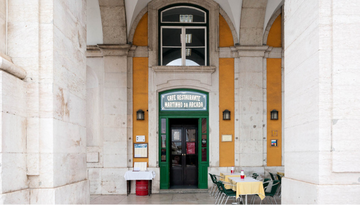 Martinho da Arcada’s mythical reputation among Lisbon’s historic eateries comes as much from its status as the oldest cafe in Lisbon as from the impressive list of artists and intellectuals that made it their favorite meeting place. Founded in 1782 under the name Casa da Neve, selling ice and drinks, it went through many owners and iterations, until it was bought in 1829 by Martinho Bartolomeu Rodrigues, who gave it its current name. Many of the great names in Portuguese literature, theater, film and fine arts are honored on the walls of this historic establishment. However, Martinho da Arcada’s most notorious customer is unarguably the poet Fernando Pessoa, who regularly frequented the cafe, and there met fellow intellectuals, and wrote some of his work at a table that to this day is reserved for him, exhibiting copies of his work and memorabilia.
Martinho da Arcada’s mythical reputation among Lisbon’s historic eateries comes as much from its status as the oldest cafe in Lisbon as from the impressive list of artists and intellectuals that made it their favorite meeting place. Founded in 1782 under the name Casa da Neve, selling ice and drinks, it went through many owners and iterations, until it was bought in 1829 by Martinho Bartolomeu Rodrigues, who gave it its current name. Many of the great names in Portuguese literature, theater, film and fine arts are honored on the walls of this historic establishment. However, Martinho da Arcada’s most notorious customer is unarguably the poet Fernando Pessoa, who regularly frequented the cafe, and there met fellow intellectuals, and wrote some of his work at a table that to this day is reserved for him, exhibiting copies of his work and memorabilia.
Nowadays, visiting Martinho da Arcada means not only breathing in the history of Lisbon, but also enjoying many of its classic offers, among which the famous bife à Martinho, a steak swimming in a delicious coffee and cream sauce.
📍Praça do Comércio 3, 1100-148 Lisbon
Photo by Comércio com História
Restaurante Tavares, 1784
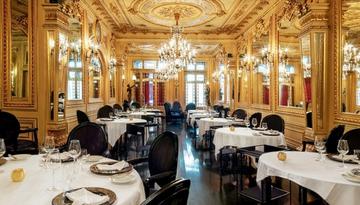 Martinho da Arcada might hold the title of the oldest cafe in Lisbon, but Tavares is not only the oldest restaurant in Portugal, but also the 10th oldest restaurant in the world. Famous writers like Camilo Castelo Branco and Eça de Queirós patronized this establishment throughout its history, and Eça even used the restaurant as a setting for a fictional dinner in his greatest work, “Os Maias”. Famous for introducing Portuguese palates to foreign delicacies, like foie gras, it continues to pride itself on the luxury experience it provides to diners. Each one of its tables is dedicated to one of its famous guests, from the philanthropist Calouste Gulbenkian, to household names like Hemmingway, Jean Paul Gaultier and Madonna. Some of the classic dishes that are part of the history of Tavares are the sole meuniere and the partridge “à Convento de Alcântara”. Currently closed for restoration, it promises to return revitalized, keeping its pride of place as luxurious space, as beautiful as ever.
Martinho da Arcada might hold the title of the oldest cafe in Lisbon, but Tavares is not only the oldest restaurant in Portugal, but also the 10th oldest restaurant in the world. Famous writers like Camilo Castelo Branco and Eça de Queirós patronized this establishment throughout its history, and Eça even used the restaurant as a setting for a fictional dinner in his greatest work, “Os Maias”. Famous for introducing Portuguese palates to foreign delicacies, like foie gras, it continues to pride itself on the luxury experience it provides to diners. Each one of its tables is dedicated to one of its famous guests, from the philanthropist Calouste Gulbenkian, to household names like Hemmingway, Jean Paul Gaultier and Madonna. Some of the classic dishes that are part of the history of Tavares are the sole meuniere and the partridge “à Convento de Alcântara”. Currently closed for restoration, it promises to return revitalized, keeping its pride of place as luxurious space, as beautiful as ever.
📍Rua da Misericórdia 37 R/C, 1200-270 Lisbon
Photo by Vogue
Confeitaria Nacional, 1829
 The oldest confectionery in the city, it further cemented its legendary status after becoming the official supplier of the Portuguese royal family, in 1873. Modeled after the finest Parisian patisseries, it has kept its place as one of the most beloved pastry shops in the city for almost two centuries, still in the hands of the family of its original founder, Balthazar Roiz Castanheiro. In 1870, Baltazar Castanheiro Júnior, the son of the founder of Confeitaria Nacional, brought the recipe of the french gâteau des rois from Paris, adapting it and turning it into what is today the most famous Christmas sweet treat in the country, the bolo rei. Despite its ubiquity throughout the country, it is in this establishment that one can find “the real deal”, and around the holidays clients line up to buy the famed cake, still warm from the ovens of this true Lisbon institution. Apart from the many pastries and traditional biscuits it has on offer, this confectionery is worth visiting for its elegant architecture and decor alone. And if one is in the mood for something more substantial, Confeitaria Nacional also offers lunch menus in the dining area upstairs, with items that go from traditional Portuguese soups and mains to more international dishes that can suit any palate.
The oldest confectionery in the city, it further cemented its legendary status after becoming the official supplier of the Portuguese royal family, in 1873. Modeled after the finest Parisian patisseries, it has kept its place as one of the most beloved pastry shops in the city for almost two centuries, still in the hands of the family of its original founder, Balthazar Roiz Castanheiro. In 1870, Baltazar Castanheiro Júnior, the son of the founder of Confeitaria Nacional, brought the recipe of the french gâteau des rois from Paris, adapting it and turning it into what is today the most famous Christmas sweet treat in the country, the bolo rei. Despite its ubiquity throughout the country, it is in this establishment that one can find “the real deal”, and around the holidays clients line up to buy the famed cake, still warm from the ovens of this true Lisbon institution. Apart from the many pastries and traditional biscuits it has on offer, this confectionery is worth visiting for its elegant architecture and decor alone. And if one is in the mood for something more substantial, Confeitaria Nacional also offers lunch menus in the dining area upstairs, with items that go from traditional Portuguese soups and mains to more international dishes that can suit any palate.
📍Praça da Figueira 18B, 1100-241 Lisbon
https://confeitarianacional.com
Photo by Lojas Com História
Antiga Confeitaria de Belém (aka Pastéis de Belém), 1837
A rguably the most famous patisserie in the country, as evidenced by the lines of customers that can be seen outside it at any hour of the day, the Antiga Confeitaria de Belém has as its trademark the iconic pastel de Belém. Originally developed by monks in the Mosteiro dos Jerónimos, a famous monastery that is situated a few minutes from the patisserie, the recipe of these delicious pastéis was passed to this shop. To this day it is kept under secret, known only by the main patissier, who prepares the pastéis in the Oficina do Segredo, a secret room where the magic that produces these pastries is protected from prying eyes. Generations of both Lisboners and tourists have been visiting this veritable institution, enjoying a pastel and an espresso, and taking home half a dozen (or more) to share with loved ones. Traditionally sprinkled with cinnamon and/or powdered sugar and ideally eaten still warm, these pastries are the quintessential Portuguese sweet treat, the original that spawned copies throughout the country and the world.
rguably the most famous patisserie in the country, as evidenced by the lines of customers that can be seen outside it at any hour of the day, the Antiga Confeitaria de Belém has as its trademark the iconic pastel de Belém. Originally developed by monks in the Mosteiro dos Jerónimos, a famous monastery that is situated a few minutes from the patisserie, the recipe of these delicious pastéis was passed to this shop. To this day it is kept under secret, known only by the main patissier, who prepares the pastéis in the Oficina do Segredo, a secret room where the magic that produces these pastries is protected from prying eyes. Generations of both Lisboners and tourists have been visiting this veritable institution, enjoying a pastel and an espresso, and taking home half a dozen (or more) to share with loved ones. Traditionally sprinkled with cinnamon and/or powdered sugar and ideally eaten still warm, these pastries are the quintessential Portuguese sweet treat, the original that spawned copies throughout the country and the world.
📍Rua de Belém 84 92, 1300-085 Lisbon
Photo by Pastéis de Belém
Faz Frio, circa 1863
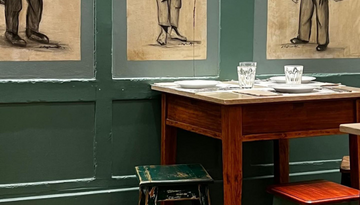 Although no one is sure of exactly when Faz Frio first opened, this stalwart of the city’s restaurant scene is beloved by locals, and manages to bring together an old time feel (with its charming wood paneled cubicles and drawings depicting traditional traders and sellers from historic Lisbon) as well as their own take on classic Portuguese dishes. It is worth exploring their menu, which changes according to what is available seasonally, but the arroz naval, a take on seafood rice that was brought to the restaurant by one of its partners in the 70’s, remains a favorite and helped cement this restaurant as a place not to miss.
Although no one is sure of exactly when Faz Frio first opened, this stalwart of the city’s restaurant scene is beloved by locals, and manages to bring together an old time feel (with its charming wood paneled cubicles and drawings depicting traditional traders and sellers from historic Lisbon) as well as their own take on classic Portuguese dishes. It is worth exploring their menu, which changes according to what is available seasonally, but the arroz naval, a take on seafood rice that was brought to the restaurant by one of its partners in the 70’s, remains a favorite and helped cement this restaurant as a place not to miss.
📍Rua Dom Pedro V 96, 1250-094 Lisbon
Photo by Miguel Moreira Rato
Pastelaria Benard, 1868
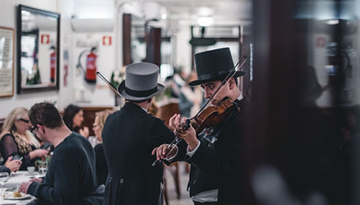 Founded by Frenchman Élie Benard, this historic establishment was originally named Padaria Franceza (French Bakery) and brought to Lisbon the classics of french and viennese baking, from baguettes and brioche to warm buns in the style of Hamburg. After the founder’s death, one of his sons, Casimiro Benard, moved the bakery to Rua Garret, and turned it into Patisserie Benard (and later Pastelaria Benard). It was then that the now legendary croissants were first produced. Apart from bread and pastries, Pastelaria Benard later started serving lunches and dinners, as well as light meals such as salads or quiches. For over a century it was seen as a meeting point of Lisbon’s polite society, and among its many guests, a dinner in honor of Queen Elizabeth II, at the time of her visit to Portugal in 1957, was perhaps the most memorable.
Founded by Frenchman Élie Benard, this historic establishment was originally named Padaria Franceza (French Bakery) and brought to Lisbon the classics of french and viennese baking, from baguettes and brioche to warm buns in the style of Hamburg. After the founder’s death, one of his sons, Casimiro Benard, moved the bakery to Rua Garret, and turned it into Patisserie Benard (and later Pastelaria Benard). It was then that the now legendary croissants were first produced. Apart from bread and pastries, Pastelaria Benard later started serving lunches and dinners, as well as light meals such as salads or quiches. For over a century it was seen as a meeting point of Lisbon’s polite society, and among its many guests, a dinner in honor of Queen Elizabeth II, at the time of her visit to Portugal in 1957, was perhaps the most memorable.
Today, locals and visitors can still see and feel the history of this classic Lisbon eatery and, perhaps even more importantly, they can still enjoy the delicious croissants that have delighted Lisboners for many decades.
📍Rua Garrett 104, 1200-205 Lisbon
Photo by Pastelaria Benard
A Brasileira, 1905
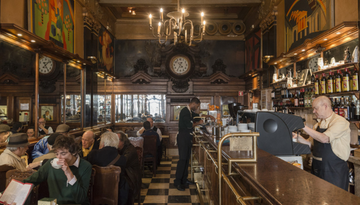 An iconic café nestled in Lisbon’s historic Chiado district, A Brasileira was founded by Adriano Telles, a former Portuguese emigrant to Brazil. Having married the daughter of one of the largest coffee producers in Brazil’s Minas Gerais region, he returned to Portugal with the desire to introduce the Portuguese public to this drink. In a time when coffee was little appreciated in Portugal due to its bitter taste, Adriano Telles established A Brasileira. In the early days of this historic place he even offered coffee to the public for free, in order to prove the quality of his product. For thirteen years, patrons could enjoy a cup of coffee without charge, even before the famous bica became a household name. Inside the sumptuous café, the who’s who of the era gathered, and even the revolutionaries who played a significant role in establishing the republic in 1910 convened here. Renowned artists like Fernando Pessoa and Almada Negreiros also frequented the cafe, turning it into one of the hubs of modernism in Portugal.
An iconic café nestled in Lisbon’s historic Chiado district, A Brasileira was founded by Adriano Telles, a former Portuguese emigrant to Brazil. Having married the daughter of one of the largest coffee producers in Brazil’s Minas Gerais region, he returned to Portugal with the desire to introduce the Portuguese public to this drink. In a time when coffee was little appreciated in Portugal due to its bitter taste, Adriano Telles established A Brasileira. In the early days of this historic place he even offered coffee to the public for free, in order to prove the quality of his product. For thirteen years, patrons could enjoy a cup of coffee without charge, even before the famous bica became a household name. Inside the sumptuous café, the who’s who of the era gathered, and even the revolutionaries who played a significant role in establishing the republic in 1910 convened here. Renowned artists like Fernando Pessoa and Almada Negreiros also frequented the cafe, turning it into one of the hubs of modernism in Portugal.
Pessoa’s presence and connection to the café gained a new importance when, in 1988 a bronze statue of Fernando Pessoa, sculpted by Lagoa Henriques, was placed on the café’s terrace. As a testament to its legacy, he now sits at a table, inviting passersby to sit with him, and turning A Brasileira into one of the most photographed spots in the capital.
📍Rua Garrett 122, 1200-205 Lisbon
Photo by Lojas Com História
A Ginjinha, 1840
 If the pastel de Belém is Lisbon’s most iconic sweet treat, then ginjinha is its liquid counterpart, equally as sweet, and dangerously easy to drink. And this small hole in the wall establishment has played a big part in popularizing this drink, making it a favorite of people of all social classes and (legal) ages. The space that is now synonymous with the consumption of this cherry liqueur came before the drink itself. A Galician emigré opened a factory and shop in the Rua das Portas de Santo Antão, where wines and liqueurs were produced and sold. But it was his son, Francisco Espiñeira Couziño, who started the production of Ginja Espinheira (aka Ginjinha Espinheira) and in 1910 moved the shop to the Largo de São Domingos, where it is located to this day. Today customers can be spotted outside the shop throughout the day. The lack of space inside the shop means that passersby will be greeted by groups of happy drinkers sipping on the liqueur that can be served with or without the cherries, according to personal preference. Ginjinha Espinheira can be bought in shops throughout the world, or even through the company’s online shop, but its flag store in the heart of Lisbon is still the best place to enjoy this beverage.
If the pastel de Belém is Lisbon’s most iconic sweet treat, then ginjinha is its liquid counterpart, equally as sweet, and dangerously easy to drink. And this small hole in the wall establishment has played a big part in popularizing this drink, making it a favorite of people of all social classes and (legal) ages. The space that is now synonymous with the consumption of this cherry liqueur came before the drink itself. A Galician emigré opened a factory and shop in the Rua das Portas de Santo Antão, where wines and liqueurs were produced and sold. But it was his son, Francisco Espiñeira Couziño, who started the production of Ginja Espinheira (aka Ginjinha Espinheira) and in 1910 moved the shop to the Largo de São Domingos, where it is located to this day. Today customers can be spotted outside the shop throughout the day. The lack of space inside the shop means that passersby will be greeted by groups of happy drinkers sipping on the liqueur that can be served with or without the cherries, according to personal preference. Ginjinha Espinheira can be bought in shops throughout the world, or even through the company’s online shop, but its flag store in the heart of Lisbon is still the best place to enjoy this beverage.
📍Largo São Domingos 8, 1100-201 Lisbon
https://ginjinhaespinheira.com
Photo by Lojas Com História
A Tendinha do Rossio, 1840
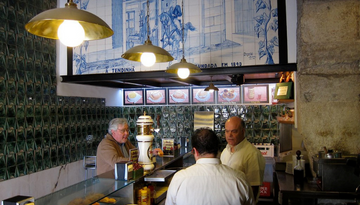 The oldest taberna in Lisbon has quenched the thirst of generations of Lisboners since 1840, but it does more than serve vinho verde, ginjinha or draft beer to locals and tourists. From its exceptionally small space it provides cheap, quick and delicious snacks like croquetes and other traditional fried foods, as well as soups and truly portuguese classics like dry-cured ham or fried codfish sandwiches.
The oldest taberna in Lisbon has quenched the thirst of generations of Lisboners since 1840, but it does more than serve vinho verde, ginjinha or draft beer to locals and tourists. From its exceptionally small space it provides cheap, quick and delicious snacks like croquetes and other traditional fried foods, as well as soups and truly portuguese classics like dry-cured ham or fried codfish sandwiches.
Despite becoming a favorite with tourists that come in for a break walking up the hills of Lisbon all day, it is still, undeniably, a classic tavern, with its relaxed atmosphere and spartan, but charming décor.
📍Praça Dom Pedro IV 6, 1100-200 Lisbon
Photo by Restos de Colecção
A Ginjinha Sem Rival (Eduardino), 1890
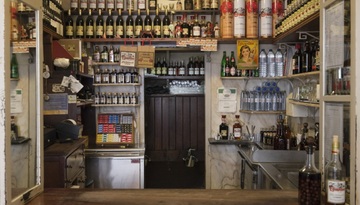 Founded in 1890 by João Lourenço Cima, it is still a family business, thriving in the bustling Rua das Portas de Santo Antão, in the historic home of the theater world in Lisbon, near spaces like the Teatro Nacional Dona Maria II, the Politeama and the Coliseu de Lisboa. Being so close to the world of the performing arts, it is no wonder that this establishment’s history crossed paths with the bohemian world of performers. Although its most sold drink is the popular ginjinha it is the Eduardino, a liqueur featuring the classic cherry, with an addition of aniseed and other aromatics, that best encapsulates the history and charm of this place. Legend says that Eduardino, a clown who regularly performed at the Coliseu de Lisboa and was a regular at Ginjinha Sem Rival, one day decided to mix ginjinha with other liqueurs, creating a blend of flavors that quickly became popularized and later started to be bottled and sold at the shop. Eduardino was immortalized in the bottle of this liqueur, in his clown’s costume, and a classic Lisbon drink was born. One can still drink it today at the shop, or buy it bottled. And in shops around Lisbon (like in the Tendinha do Rossio) it is also possible to find the liqueurs of Ginjinha Sem Rival, a tiny shop with a big history.
Founded in 1890 by João Lourenço Cima, it is still a family business, thriving in the bustling Rua das Portas de Santo Antão, in the historic home of the theater world in Lisbon, near spaces like the Teatro Nacional Dona Maria II, the Politeama and the Coliseu de Lisboa. Being so close to the world of the performing arts, it is no wonder that this establishment’s history crossed paths with the bohemian world of performers. Although its most sold drink is the popular ginjinha it is the Eduardino, a liqueur featuring the classic cherry, with an addition of aniseed and other aromatics, that best encapsulates the history and charm of this place. Legend says that Eduardino, a clown who regularly performed at the Coliseu de Lisboa and was a regular at Ginjinha Sem Rival, one day decided to mix ginjinha with other liqueurs, creating a blend of flavors that quickly became popularized and later started to be bottled and sold at the shop. Eduardino was immortalized in the bottle of this liqueur, in his clown’s costume, and a classic Lisbon drink was born. One can still drink it today at the shop, or buy it bottled. And in shops around Lisbon (like in the Tendinha do Rossio) it is also possible to find the liqueurs of Ginjinha Sem Rival, a tiny shop with a big history.
📍Rua das Portas de Santo Antão 7, 1150-264 Lisbon
www.facebook.com/GinjaSemRivaleEduardino
Photo by Comércio com História
A Licorista, 1920
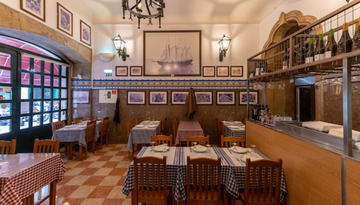 Another establishment famously patronized by the poet Fernando Pessoa, A Licorista was founded in 1920 by the owners of a company of the same name, that manufactures liqueurs made from fruits grown in Portugal. Apart from its quaint decór that references the history of this very traditional eatery, it is the food, as classic as it is affordable, that stands out and makes it a sure bet for a leisurely lunch or dinner.
Another establishment famously patronized by the poet Fernando Pessoa, A Licorista was founded in 1920 by the owners of a company of the same name, that manufactures liqueurs made from fruits grown in Portugal. Apart from its quaint decór that references the history of this very traditional eatery, it is the food, as classic as it is affordable, that stands out and makes it a sure bet for a leisurely lunch or dinner.
Since 1997 it has also occupied the space next door, O Bacalhoeiro, where salted cod beloved by the Portuguese used to be sold. Taking into account this connection with the country’s most beloved fish, one can safely say that ordering a bacalhau à Minhota (fried cod, Northern Portuguese style), or bacalhau à Lagareiro (roasted cod loin with olive oil) will always be a good idea.
📍Rua dos Sapateiros 218, 1100-587 Lisbon
www.facebook.com/alicoristaobacalhoeiro
Photo by Comércio com História
Pastelaria Versailles, 1922
 With its Art Nouveau inspired decor, impressive facade, large mirrors and waiters dressed in elegant uniforms, Pastelaria Versailles lives up to its name, inspired by the luxury of the French palace. The first proper cafe in the Saldanha area, it has been a beacon of refinement in this part of the city, offering coffee, drool inducing pastries and cakes (including their signature chocolate cake, very famous around town), savory treats and even meals. In 2017 it opened a second location in Belém, which is also characterized by its elegance, and the Versailles group has even opened an ice cream parlor nearby, but the classic café in the Avenida da República is still the best place to experience the luxurious ambiance of this Lisbon institution.
With its Art Nouveau inspired decor, impressive facade, large mirrors and waiters dressed in elegant uniforms, Pastelaria Versailles lives up to its name, inspired by the luxury of the French palace. The first proper cafe in the Saldanha area, it has been a beacon of refinement in this part of the city, offering coffee, drool inducing pastries and cakes (including their signature chocolate cake, very famous around town), savory treats and even meals. In 2017 it opened a second location in Belém, which is also characterized by its elegance, and the Versailles group has even opened an ice cream parlor nearby, but the classic café in the Avenida da República is still the best place to experience the luxurious ambiance of this Lisbon institution.
📍Av. da República 15 A, 1050-185 Lisbon
Photo by Lojas Com História
As Velhas, 1925
 This restaurant, characterized by its warm and welcoming atmosphere, with its low ceilings and dark wood accents, had a quite humble beginning. Although no one can tell exactly when the restaurant first started, we can safely say that it is older than the official date, which makes it a centenary establishment. The “velhas” referenced in its name were two old ladies from the region of Minho, who first started this restaurant, cooking and serving meals to hungry Lisboners craving the hearty and delicious food from the north of Portugal. Bought in the 80s by the famous boxer Manuel Gonçalves, it is now run by his son, and still has a dish from Minho (bacalhau à Minhota) as one of its specialties.
This restaurant, characterized by its warm and welcoming atmosphere, with its low ceilings and dark wood accents, had a quite humble beginning. Although no one can tell exactly when the restaurant first started, we can safely say that it is older than the official date, which makes it a centenary establishment. The “velhas” referenced in its name were two old ladies from the region of Minho, who first started this restaurant, cooking and serving meals to hungry Lisboners craving the hearty and delicious food from the north of Portugal. Bought in the 80s by the famous boxer Manuel Gonçalves, it is now run by his son, and still has a dish from Minho (bacalhau à Minhota) as one of its specialties.
📍Rua da Conceição da Glória 21, 1250-079 Lisbon
www.instagram.com/asvelhaslisboa
Photo by As Velhas
Café Nicola, 1927
 Although its current incarnation as a cafe dates back to 1929, its roots are much older. In the 18th century, an Italian by the name of Nicola started his “Botequim do Nicola” (Nicola’s Tavern), which had the poet Manuel Maria Barbosa du Bocage as its most famous patron. At a time of deep social turmoil, the botequim became the center of the literary and political world of the capital. The second incarnation of the Nicola, now as a cafe, has a less dramatic story. Bought by Joaquim Fonseca Albuquerque in 1929, and renovated six years later, it keeps to this day the elegant and geometric Art Deco style envisioned by the architect Raul Tojal.
Although its current incarnation as a cafe dates back to 1929, its roots are much older. In the 18th century, an Italian by the name of Nicola started his “Botequim do Nicola” (Nicola’s Tavern), which had the poet Manuel Maria Barbosa du Bocage as its most famous patron. At a time of deep social turmoil, the botequim became the center of the literary and political world of the capital. The second incarnation of the Nicola, now as a cafe, has a less dramatic story. Bought by Joaquim Fonseca Albuquerque in 1929, and renovated six years later, it keeps to this day the elegant and geometric Art Deco style envisioned by the architect Raul Tojal.
Café Nicola is intrinsically connected to the story and the habit of Portuguese coffee drinking, and the coffee blend served by this cafe eventually became a household name, being now sold in every supermarket in the country. Nowadays one can enjoy more than just coffee, and the steak that is the house specialty, bife à Nicola, should be enough to warrant a visit to this historic spot.
📍Praça Dom Pedro IV 24/25 1200-091 Lisbon
Photo by Be Hotel Lisboa
A Ginjinha Popular, 1931
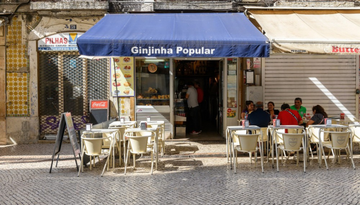 Despite its location in the touristic Rua de Santo Antão, and surrounded by restaurants catering to travelers, A Ginjinha Popular remains defiantly local, being a meeting point for neighbors and Lisboners who work nearby. Apart from serving ginjinha (it sells the brand Ginjinha Sem Rival, from the shop of the same name that is also located on the same street) it is known and loved by the quick snacks like pataniscas (cod fritters) and sandes de panado (breaded and fried pork meat sandwiches), usually served with a cold beer and a view of the bustling street, where tourists and aficionados of theater cross paths.
Despite its location in the touristic Rua de Santo Antão, and surrounded by restaurants catering to travelers, A Ginjinha Popular remains defiantly local, being a meeting point for neighbors and Lisboners who work nearby. Apart from serving ginjinha (it sells the brand Ginjinha Sem Rival, from the shop of the same name that is also located on the same street) it is known and loved by the quick snacks like pataniscas (cod fritters) and sandes de panado (breaded and fried pork meat sandwiches), usually served with a cold beer and a view of the bustling street, where tourists and aficionados of theater cross paths.
This classic spot might not be the most glamorous, but it is certainly not lacking in character and authenticity.
📍Rua das Portas de Santo Antão 65, 1150-265 Lisbon
Photo by Lojas Com História
Gambrinus, 1936
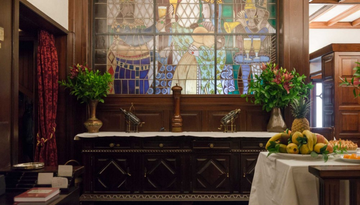 If it feels like Gambrinus hasn’t been around for that long, it’s really not because this is a new business… It’s mostly because the other establishments highlighted here are really quite old! Founded in 1936, it was first a charcuterie, later on a brewery, and only in 1964 did it become the refined restaurant that artists and politicians frequent to this day, after its extensive renovation, headed by the architect Maurício de Vasconcelos. Its facade hides its elegant interior, with its wooden panels, stained glass and tapestries. It is famous for its classics like Eisbein (ham hock) with sauerkraut and fish soup. However, it is also famous for elevating the humble croquete to new tasty heights, always served with mustard in a delightful pairing. Whether serving caviar or croquette, what is guaranteed at Gambrinus is that it will make you feel part of Lisbon’s history.
If it feels like Gambrinus hasn’t been around for that long, it’s really not because this is a new business… It’s mostly because the other establishments highlighted here are really quite old! Founded in 1936, it was first a charcuterie, later on a brewery, and only in 1964 did it become the refined restaurant that artists and politicians frequent to this day, after its extensive renovation, headed by the architect Maurício de Vasconcelos. Its facade hides its elegant interior, with its wooden panels, stained glass and tapestries. It is famous for its classics like Eisbein (ham hock) with sauerkraut and fish soup. However, it is also famous for elevating the humble croquete to new tasty heights, always served with mustard in a delightful pairing. Whether serving caviar or croquette, what is guaranteed at Gambrinus is that it will make you feel part of Lisbon’s history.
📍Rua das Portas de Santo Antão 25 1150-264 Lisbon
Photo by Lojas Com História
O Policia, 1938
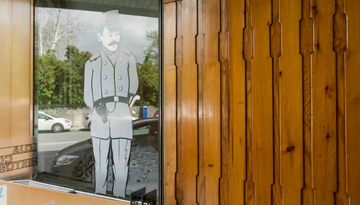 This famed Lisbon restaurant has managed the rare feat of still belonging to the family of the former policeman who founded it as a humble “casa de pasto” in the beginning of the 20th century. It is now run by the founders’ granddaughters, and maintains its commitment to serving the traditional Portuguese fare that its customers love. The decor is also staunchly Portuguese, full of tiles, family memorabilia and photographs of bullfighting scenes, which highlight its proximity with Lisbon’s bullfighting rink, in Campo Pequeno. Serving some of the greatest classics of our cuisine, such as choquinhos de coentrada (pan fried baby cuttlefish with coriander) or amêijoas à Bulhão Pato, it also offers, from Wednesday to Saturday, the most traditional of this country’s dishes: cozido à Portuguesa. If a taste of tradition and comfort food is what you’re looking for, then this is certainly the place to visit.
This famed Lisbon restaurant has managed the rare feat of still belonging to the family of the former policeman who founded it as a humble “casa de pasto” in the beginning of the 20th century. It is now run by the founders’ granddaughters, and maintains its commitment to serving the traditional Portuguese fare that its customers love. The decor is also staunchly Portuguese, full of tiles, family memorabilia and photographs of bullfighting scenes, which highlight its proximity with Lisbon’s bullfighting rink, in Campo Pequeno. Serving some of the greatest classics of our cuisine, such as choquinhos de coentrada (pan fried baby cuttlefish with coriander) or amêijoas à Bulhão Pato, it also offers, from Wednesday to Saturday, the most traditional of this country’s dishes: cozido à Portuguesa. If a taste of tradition and comfort food is what you’re looking for, then this is certainly the place to visit.
📍Rua Marquês Sá da Bandeira 112A, 1050-150 Lisbon
https://restauranteopolicia.com
Photo by Lojas Com História
A Panificação Mecânica, 1942
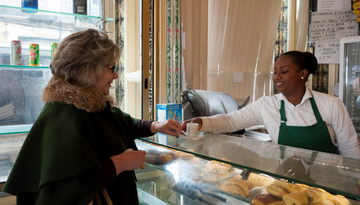 Established in the charming and slightly off the beaten path area of Campo de Ourique, A Panificação Mecânica was one of the spots that were essential in creating the lively neighborhood feel that characterizes this part of the city. The beauty of the building where it is situated, as well as its truly enchanting interior, compete with the truly mouth watering array of breads, pastries, biscuits and sweets on display for the customers to choose from. There is a very good selection of miniature pastries, for those who have trouble deciding what to choose. And if one needs something more substantial, there is more to this shop than just sweet treats. For lunch there are always soups and the daily specials that will take care of any hungry customer, and savory pastries like the delicious empada de frango (chicken pie) are perfect to eat between meals, while you watch the neighbors coming in and out of this delightful space.
Established in the charming and slightly off the beaten path area of Campo de Ourique, A Panificação Mecânica was one of the spots that were essential in creating the lively neighborhood feel that characterizes this part of the city. The beauty of the building where it is situated, as well as its truly enchanting interior, compete with the truly mouth watering array of breads, pastries, biscuits and sweets on display for the customers to choose from. There is a very good selection of miniature pastries, for those who have trouble deciding what to choose. And if one needs something more substantial, there is more to this shop than just sweet treats. For lunch there are always soups and the daily specials that will take care of any hungry customer, and savory pastries like the delicious empada de frango (chicken pie) are perfect to eat between meals, while you watch the neighbors coming in and out of this delightful space.
📍Rua Silva Carvalho 209, 1250-249 Lisbon
Photo by Lojas Com História
Which of these places are you looking forward to visiting the most when you travel to Lisbon? When you make it there, please share your photos with us via Instagram. Please tag us @tasteoflisboa #tasteoflisboa
We’ll love to see your photo shoots, to know about your insights, questions, suggestions and wishes on your food & culture experiences in Lisbon and Portugal. Please share with us via Instagram Facebook,or Twitter and tag us @tasteoflisboa or #tasteoflisboa.
Feed your curiosity on Portuguese food culture:
Set the table – Portuguese essentials
Iconic foods and places Lisbon locals love
What do Portuguese people eat at home?
Real people, real food. Come with us to where the locals go.
Signup for our natively curated food & cultural experiences.
Follow us for more at Instagram, Twitter e Youtube
